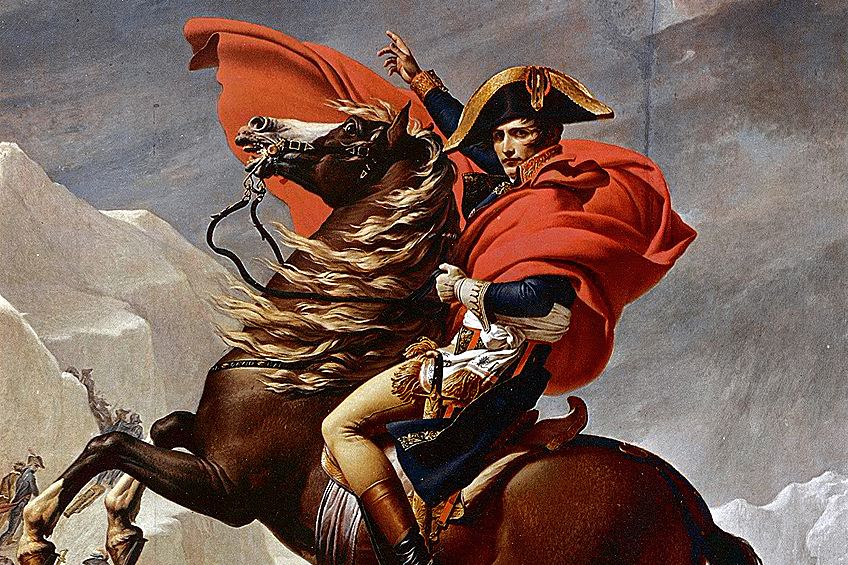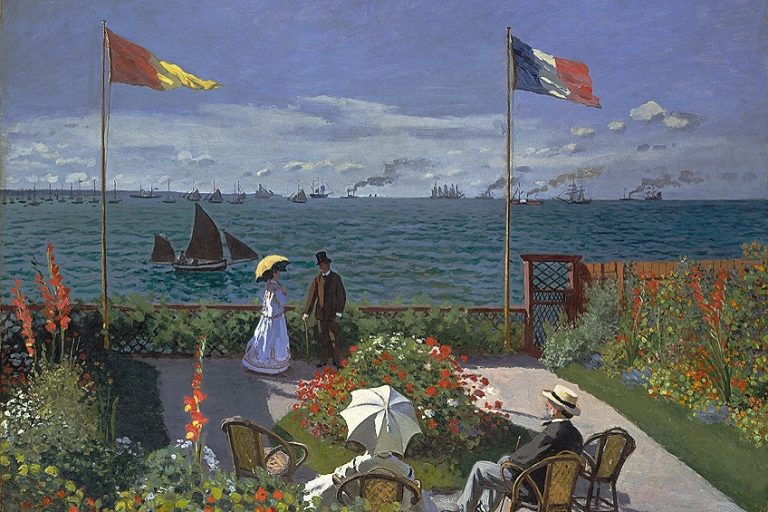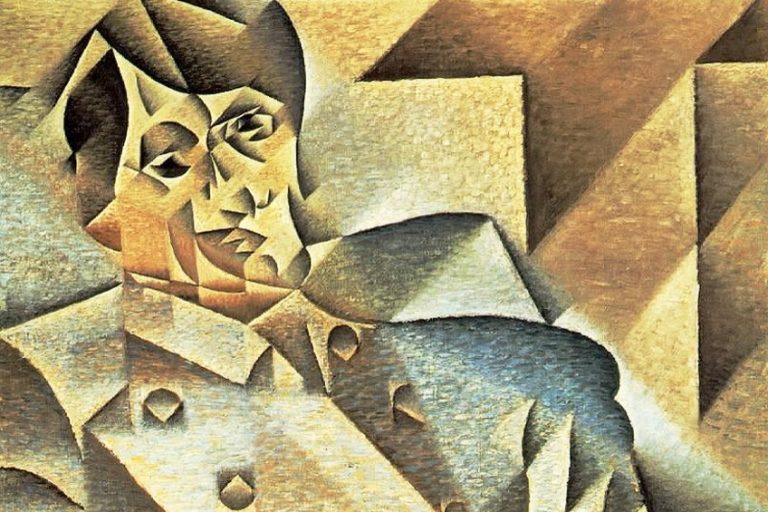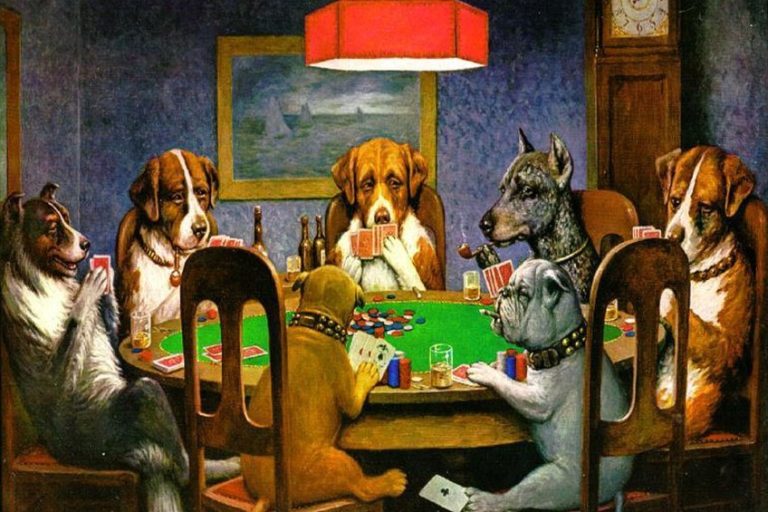“Napoleon Crossing the Alps” by Jacques-Louis David – Analysis
The painting of Napoleon Bonaparte Crossing the Alps (c.1801) by Jacques-Louis David has been one of the most famous renditions of the French leader Napoleon Bonaparte, with numerous copies of it too. This article will discuss the first version produced by David, who was in his own right a French leader in the Neoclassical art movement.
Artist Abstract: Who Was Jacques-Louis David?
Jacques-Louis David was born on August 30, 1748, and died on December 29, 1825. He was born in Paris and loved art from an early age, and became a pioneering artist of Neoclassicism. He was educated at the Royal Academy of Painting and Sculpture and sought to win the Prix de Rome, which he only won after several attempts. His travels through Italy exposed him to great artworks and artists, for example, Raphael. David was also political and part of the French Revolution uprisings, specifically the Jacobin Club. Some of his famous paintings include Oath of the Horatii (1784), The Death of Socrates (1787), and The Death of Marat (1793).
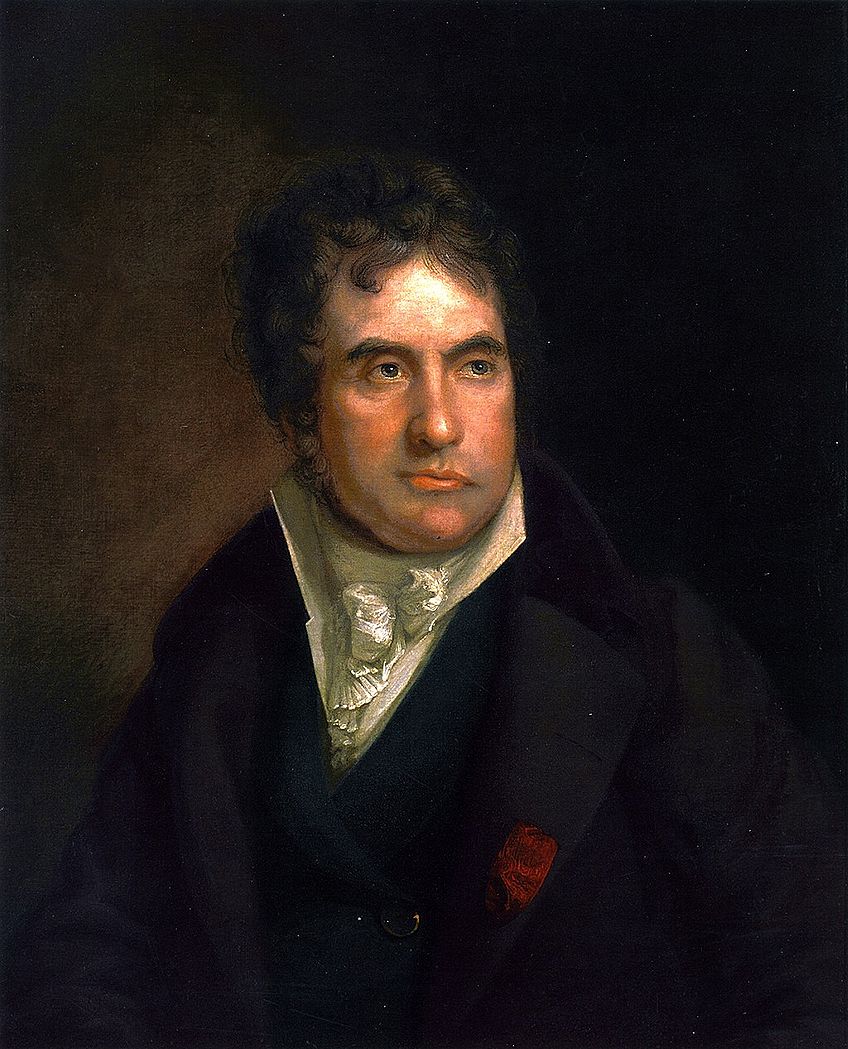
Napoleon Crossing the Alps (c.1801) by Jacques-Louis David in Context
The article below will explore the Napoleon Crossing the Alps analysis, which will discuss a contextual overview of why Jacques-Louis David painted it as well as a look at his artistic style in terms of the art elements and principles.
| Artist | Jacques-Louis David (1748 – 1825) |
| Date Painted | c. 1801 |
| Medium | Oil on canvas |
| Genre | History painting |
| Period / Movement | Neoclassicism |
| Dimensions (cm) | 261 x 221 |
| Series / Versions | The first of five versions |
| Where Is It Housed? | Château de Malmaison, Rueil-Malmaison, Paris, France |
| What It Is Worth | N/A |
Contextual Analysis: A Brief Socio-Historical Overview
Jacques-Louis David, who painted the famous picture of Napoleon Crossing the Alps, was one of the foremost Neoclassical artists. Before we look at why he painted Napoleon at Saint Bernard Pass, it will help to know a bit more about what the Neoclassical art movement stood for and what the artistic outlook was.
This was also during a time of the Enlightenment, otherwise also known as the Age of Reason, when philosophical ideas and new modes of critical thinking prevailed and influenced the way many people believed the world and themselves to be.

Neoclassicism was active during the 18th century (that would be the 1700s) and the word is a combination of the “neo”, which is defined as “new” or “recent” and “classic”, which refers to art from the Classical art from ancient Greece and Rome. It has also been described as a “revival” of classical art and ideals, focusing on “symmetry” and “order”, following science and form. It is compared to its predecessor art styles, which were the Baroque and Rococo. Specifically, the latter, the Rococo, has been described as “asymmetrical” and “ornamental” and it was this “frivolity” that inspired the new classical art that had more structure and was more sober, so to say.
Painting of Napoleon Bonaparte: Propaganda, Idealism, and Mule
What does the painting of Napoleon Bonaparte have to do with understanding Neoclassicism? Jacques-Louis David’s artworks were historical renditions that emulated classical ideals, and his subjects were often figures of power in leadership related to his day and age’s political climate, which would have been the French Revolution. David portrayed Napoleon as calm and powerful in his countenance.
The painting has also been described as idealistic and propagandistic in attempts to elevate Napoleon’s public image as he became the First Consul in 1799 and introduced new laws and reforms; he also brought the French Revolution to an end.
An interesting detail about David’s painting of Napoleon Bonaparte is that it depicts the French leader on a stallion, who requested to be depicted in that way compared to how he really crossed the Saint Bernard Pass, which was reportedly on a mule and only after his men crossed over the pass.
Interestingly, the French artist Paul Delaroche created a painting of Napoleon Bonaparte, titled Bonaparte Crossing the Alps (1850), which is housed at the Walker Art Gallery in Liverpool, in London. The oil on canvas depicts the French leader on a mule instead of the impassioned portrayal of Jacques-Louis David’s stallion.
There is a man walking on Napoleon’s left and what appears to be his troops following from behind visible from the horse behind Napoleon. The environment is snow-filled, and the men are walking on a narrow, rocky mountain pass.

Delaroche was inspired by Jacques-Louis David’s portrayal of Napoleon Bonaparte and sought to depict a version of the event that was slightly more accurate in detail. The painting was commissioned by Arthur George, who reportedly wanted a depiction that was closer to what really took place.
Reportedly, as the story is recounted, in 1848 Delaroche and George viewed Napoleon Crossing the Alps by Jacques-Louis David when they were in the Louvre, where it was exhibited in 1801. Apparently, George was also a Napoleon collector. Delaroche reportedly created two renditions of Bonaparte Crossing the Alps, and the other version is held at the Louvre Museum in Paris, France.
Napoleon Did Not Want to Pose for His Painting
Napoleon Crossing the Alps by Jacques-Louis David was commissioned by the King of Spain, Charles IV, the latter wanted to have a painting of Napoleon alongside several other notable leaders who made their mark. But, as the famous and often-told story goes, Napoleon reportedly declined to pose for the painting and David apparently worked from another image of the French Emperor. Furthermore,
Napoleon is often quoted as having said to David, “Nobody knows if the portraits of the great men resemble them, it is enough that their genius lives there”.
The Other Four Napoleon Crossing the Alps Versions
There are four more versions of the painting Napoleon Crossing the Alps by Jacques-Louis David, three of which were commissioned by Napoleon Bonaparte himself, and the final version done by David, which he reportedly kept at his art studio.
After the original, or first version, the second version was painted in 1801 and is housed at the Charlottenburg Palace in Berlin, Germany. The third version was painted in 1802 and is at the Palace of Versailles in Paris, France. The fourth version was painted in 1803 and is housed at the Belvedere in Vienna, Austria. The final and fifth version is at the Palace of Versailles.
Jacques-Louis David painted each subsequent version with varying differences, notably the change in Napoleon’s cloak color, which was painted red, which is evident in the second version at Charlottenburg Palace as well as the version at Belvedere. The horse’s color also varied from light to dark.
Formal Analysis: A Brief Compositional Overview
The following Napoleon Crossing the Alps analysis will explore the formal art elements that compose the visual building blocks behind the famous painting of Napoleon Bonaparte but let us first provide a visual description of the subject matter to gain a clearer understanding of it. It is important to note that we will focus on the original that David painted from late 1800 to early 1801.

Subject Matter: Visual Description
In Napoleon Crossing the Alps by Jacques-Louis David we come face to face with the man himself, Napoleon Bonaparte. He is the central figure in the composition, straddled upon his white horse, which is classified as an Arabian stallion. The landscape surrounding them depicts a mountainous region and it appears as if they are ascending the crags. Napoleon’s right arm is outstretched, and he is pointing his index finger ahead of him whilst directly gazing in our (the viewers’) direction. He appears calm and confident as his stallion is energized and rearing its head.
The background depicts a mountainous region with various troops ascending the mountain’s pass behind Napoleon. The mountain pass in question relates to the Saint Bernard Pass in the Swiss Alps through which Napoleon traveled.
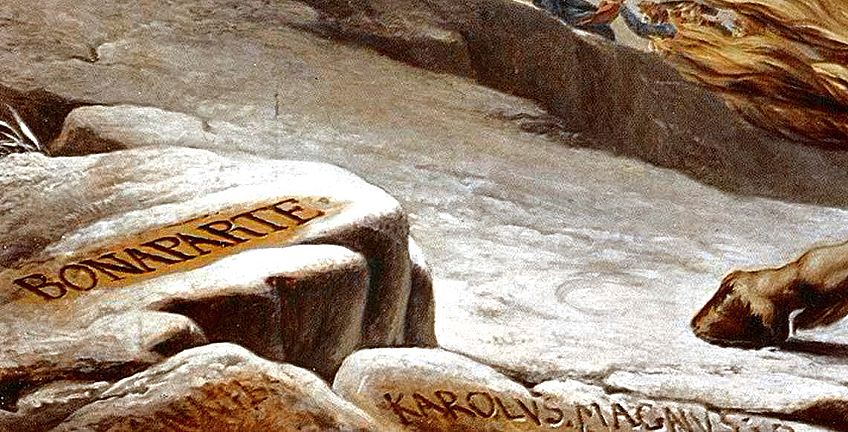
There are three engravings on the rocks in the bottom left foreground, the rock on the far left reads “BONAPARTE”, the rock in the middle “HANNIBAL”, and the rock to the right “KAROLVS MAGNVS IMP”, who was known as Charlemagne or Charles the Great. Reportedly, the inclusion of the names was in remembrance of other leaders who also crossed the Alps. The horse’s breast strap also reads the artist’s name, “DAVID”.
Color
The color scheme in Napoleon Crossing the Alps by Jacques-Louis David consists mostly of a subdued color palette, which creates a color harmony for the overall composition; there are no stark colors standing out, and the only colors that add subtle contrast consist of the blue and yellows from Napoleon’s clothing, but even these blends in with the other, earthier, color schemes. From the softer whites of the horse, the mustardy-gold cloak, the beige of his tights, and the browns from the rocky region in the background.

Line
There appears to be no visible outlines in Napoleon Crossing the Alps by Jacques-Louis David, which is part and parcel of David’s artistic approach to depicting clean delineations. There are strong implied directional lines, for example, the diagonal lines of the horse’s powerful rearing stance alongside Napoleon’s outstretched right arm and pointed finger and his swaying cloak. These create more dynamism in the overall composition and give us, the viewers, more information about the direction of movement.
Additionally, these lines have also been described as contrasting with the direction of the clouds, which also creates a balancing effect for the subject matter.

Texture
Jacques-Louis David’s composition appears well-defined and clear, which was one of his artistic traits, as well as what was prevalent in the Neoclassical style. In the painting of Napoleon Bonaparte, Jacques-Louis David’s brushwork does not really show, and the canvas is left with a smooth painted surface. Some of the implied texture is depicted in the grittiness of the rocks, the horse’s curling hair, as well as the soft folds of Napoleon’s wind-blown cloak.

Shape and Form
Napoleon Crossing the Alps by Jacques-Louis David consists of naturalistic, or organic, shapes and forms, in other words, it follows nature, from the human to animal figures to the more static environment around them like the rocks and mountains.
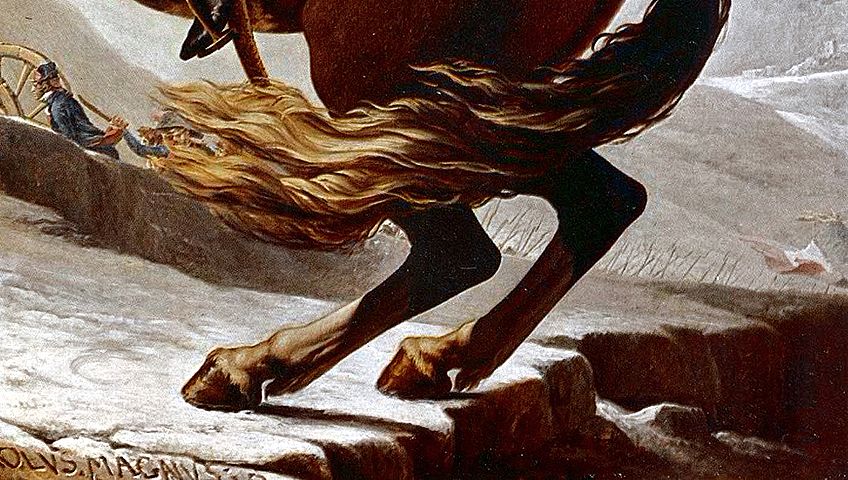
Space
Jacques-Louis David placed Napoleon and his stallion as the central subjects, which take up most of the compositional space in the foreground. A sense of spatial depth is created by making the frontal subjects clearer and the background hazier in color, so that all emphasis is on Napoleon.
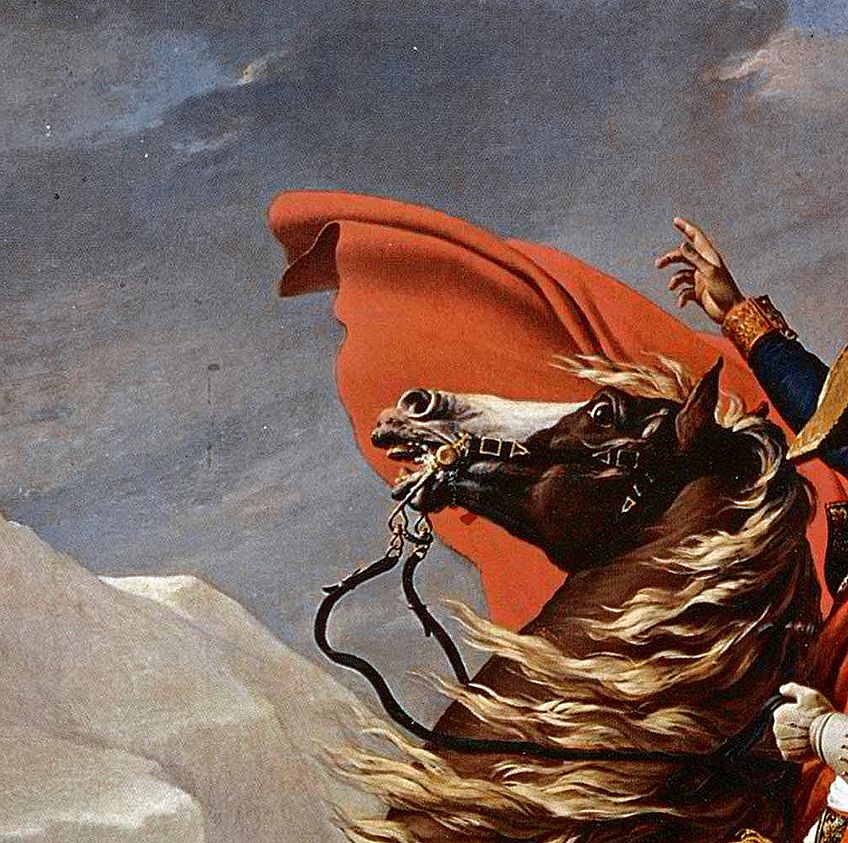
About a Hero, a Man, and a Horse
Some of the commentaries on Jacques-Louis David’s style and portrayal of Napoleon Bonaparte have been around its appearance as too statuesque and interestingly the artist also found inspiration from the statue The Bronze Horseman (1768 – 1782) by Étienne Maurice Falconet. The artist represented a heroized political leader on a strong stallion in celebration of his wartime victory. This painting of Napoleon Bonaparte has also become a famous equestrian painting.

This article explored Napoleon Crossing the Alps by Jacques-Louis David, discussing several aspects of it, like when the painting was created, and who commissioned it, as well as interesting details about Napoleon at Saint Bernard Pass and his depiction as a powerful French leader. The article also specifically discussed the original and first version of the subject matter of Napoleon on his stallion, and some of the common art elements and principles that make the visual composition.
Take a look at our Napoleon painting webstory here!
Frequently Asked Questions
Who Painted the Famous Picture of Napoleon Crossing the Alps?
The Neoclassical artist Jacques-Louis David painted the famous Napoleon Crossing the Alps (1801), which is an oil on canvas depicting Napoleon Bonaparte sitting steady and confident on his horse, which reared.
How Many Versions of Napoleon Crossing the Alps by Jacques-Louis David Are There?
There are five versions of Napoleon Crossing the Alps by Jacques-Louis David, the original version was painted around 1801, and commissioned by King Charles IV. The other four versions were painted between 1801 to 1805.
Where Is the Original Napoleon Crossing the Alps Jacques-Louis David?
The original Napoleon Crossing the Alps (c. 1801) by Jacques-Louis David is housed at the Château de Malmaison, Rueil-Malmaison, in Paris, France, which reportedly received the painting in 1949 from Eugenie Bonaparte.
Alicia du Plessis is a multidisciplinary writer. She completed her Bachelor of Arts degree, majoring in Art History and Classical Civilization, as well as two Honors, namely, in Art History and Education and Development, at the University of KwaZulu-Natal, South Africa. For her main Honors project in Art History, she explored perceptions of the San Bushmen’s identity and the concept of the “Other”. She has also looked at the use of photography in art and how it has been used to portray people’s lives.
Alicia’s other areas of interest in Art History include the process of writing about Art History and how to analyze paintings. Some of her favorite art movements include Impressionism and German Expressionism. She is yet to complete her Masters in Art History (she would like to do this abroad in Europe) having given it some time to first develop more professional experience with the interest to one day lecture it too.
Alicia has been working for artincontext.com since 2021 as an author and art history expert. She has specialized in painting analysis and is covering most of our painting analysis.
Learn more about Alicia du Plessis and the Art in Context Team.
Cite this Article
Alicia, du Plessis, ““Napoleon Crossing the Alps” by Jacques-Louis David – Analysis.” Art in Context. February 9, 2023. URL: https://artincontext.org/napoleon-crossing-the-alps-by-jacques-louis-david/
du Plessis, A. (2023, 9 February). “Napoleon Crossing the Alps” by Jacques-Louis David – Analysis. Art in Context. https://artincontext.org/napoleon-crossing-the-alps-by-jacques-louis-david/
du Plessis, Alicia. ““Napoleon Crossing the Alps” by Jacques-Louis David – Analysis.” Art in Context, February 9, 2023. https://artincontext.org/napoleon-crossing-the-alps-by-jacques-louis-david/.


